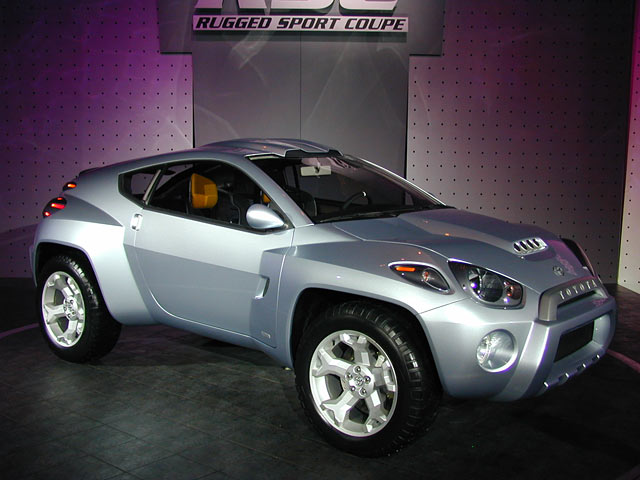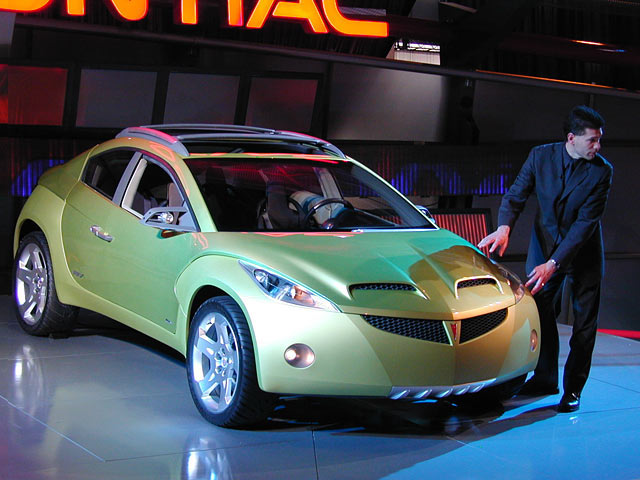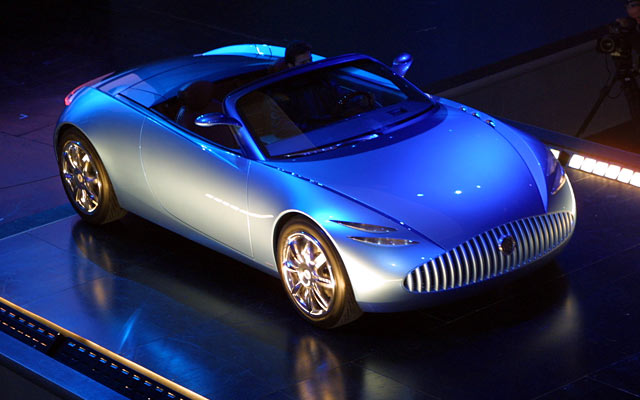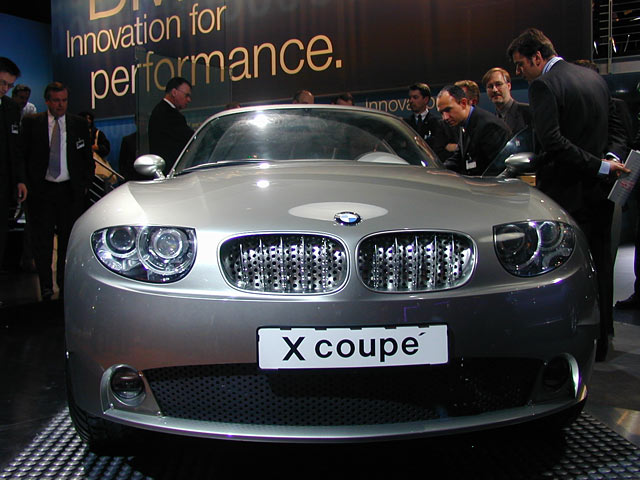|
|
|
|
This is a good place to put pictures, thumbnails, drawings, clip art, etc... These are a few of my favorite photographs from my different travels. Feel free to browse them as you like. If you want one click your right mouse button and choose "Save As" from the menu. |
|
|
|
|
| Image title would go here. Ital Design Twenty Twenty The architecture of the Twenty Twenty spider follows the lines of the Capsula (1982) and the Structura (1998), where the structural frame made its own statement as the prototype's dominant styling feature. This new proposal goes further, with the all-aluminium structure proudly on display, the body panels laid upon the frame without concealing it. Lines and shapes, usually defined by light reflected on the surfaces, are here traced by the extruded aluminium sections. "An evocative surface treatment often solves whims and trends but may present the future as frivolous, like a big toy. With Twenty Twenty, the car can return to it's roots as a complete, meticulously crafted piece of engineering", comments Giorgetto Giugiaro. When they thought of creating a spider, Giogetto and Fabrizio Giugiaro had the idea of bringing in a british firm with a great tradition in that segment. As it turned out, Aston Martin was more than willing to join them, supplying the platform and mechanicals. Giugiaro and Aston Martin had previously cooperated in 1961, when Carrozzeria Bertone worked on the two-seater DB4 Jet coupe prototype. Aluminium outlines the car, starting from the classic Aston Martin radiator grille, two main structures run the length of the car, supporting the fenders, hood and decklid, and forming the tops of the doors. The door hinges are both decorative and functional elements. Twenty Twenty is not strictly a two-seater, as the rear bulkhead can be removed to provide seating for two children. Extruded aluminium sections coherently underline the curved design of the dashboard. The instrument panel top pad floats slightly to provide a full width air vent. The center facia continues the structural theme, and incorporates a multi-function display, as well as classical toggle switches. The top of the steering wheel pad echoes the shape of the Aston Martin grille. |
 |
 |
TOYOTA RSC Toyota RSC Toyota unveiled its RSC "Rugged Sport Coupe" concept vehicle at a press conference at the 2001 Chicago Auto Show. The Toyota RSC concept was initiated and developed by CALTY Design Research, Toyota’s North American design center in Newport Beach, California. According to CALTY vice president of design, Kevin Hunter, the RSC concept was developed to explore new possibilities for a next-generation sports car, aimed specifically at young new-car buyers. "Traditionally, sports cars are influenced by high-performance on-track motor sports," said Hunter. "For the RSC concept, we looked at one of the world’s most popular off-track racing formats for inspiration. Toyota’s long history in the World Rally Championships, along with the aggressive, rugged appeal of its race cars with a young audience, made for an ideal conceptual direction. The Toyota designers joked that there's probably some influence from Sega rally videogames as well! In its effort to develop all-new products with strong appeal to young buyers, Toyota took a completely different approach in developing the RSC concept. CALTY’s primary function is to submit styling renderings, specific to products that have already been finalized for development by engineers and product planners. About a year ago, Toyota engineering asked CALTY to submit vehicle concept renderings of its own. CALTY was given no specific guidelines regarding platform, power trains or dimensions. Instead of translating a predetermined vehicle concept into a visual rendering, CALTY designers were asked to create an entirely new concept. The Rugged Sport Coupe is a pure concept vehicle. The intent, from the very beginning, was to develop a purely visual statement that would connect emotionally with young buyers. A statement that, intentionally, is not meant for everyone to understand, or appreciate. The RSC combines a sporty two-plus-two car body with four-wheel drive hardware and styling cues that result in a fresh variation on "rugged vehicle" thinking. The fuselage body design combines muscular wheel flares with edgy mechanical forms that communicates a built-for-abuse durability. The look is assembled or constructed, rather than organic. The interior of the RSC was designed to convey the sparse, functional simplicity of a race car. The look and feel suggests the notion that serious work takes place in this cockpit and that weight savings and accessibility take precedent over amenities. |
| Image title would go here. The instrument panel has a sophisticated, hand-crafted appearance: built in a race shop, rather than an assembly line. The large metal face-plate with round inset instrumentation communicates precision and ruggedness. The high-mounted sequential shifter is proposed, based on rally-car influence, as are the GPS monitor and lightweight carbon-fiber-backed racing seats with full harness restraints. With the unveiling of the RSC at the Chicago Show, and the world premiere of the all-new Matrix last month in Detroit, Toyota’s commitment to young new-car buyers is more apparent than ever. Much of the same thinking that went into the development and design of the Matrix went into the development of the RSC. Both vehicles were designed at CALTY. Both were developed to push the hot-buttons of young buyers by combining high performance, high image and high utility…with affordable pricing. "Each new generation is different, with its own culture and its own unique footprint," said TMS senior vice president and general manager, Don Esmond. "To strike a chord with young buyers, Toyota knows it must offer widely diverse products….at very attractive price points. The all-new Matrix and the RSC concept are excellent examples of Toyota’s dedication to this emerging force in the marketplace. They won’t be the last." |
 |
 |
PONTIAC REV Pontiac Rev Take a "rally" sports coupe, mix in the versatility to carry friends and cargo and you arrive at the Pontiac REV, a bold, athletic concept with a go-anywhere attitude. The REV is as capable and surefooted on smooth, twisty pavement as it is on the dirt trail headed to a favorite getaway. All-wheel-drive and on-the-fly adjustable suspension give it traction on all sorts of surfaces. "Inspired by the flexibility and performance of rally cars, REV is equally at home on trails and asphalt," said Phil Zak, 35, Brand Character Chief Designer for Pontiac. Under the front hinged clamshell hood sits a transverse mounted 3.0-liter, 245 horsepower OHC V6. The electronic sequential manual transmission with automatic mode smoothly shifts through five speeds with a sequential "joystick" operated by wire. "It’s almost like a video game," Zak said. The adjustable suspension allows the car to be raised two inches when the going gets rough. Wide 19-inch wheels in front and 20-inchers in the rear expose large ventilated disc brakes and high performance calipers. "REV’s look is that of high-tech sporting goods - fenders and rocker panels are made from ultra-tough composite material that extends into the wheel wells, under the hood and to the deck lid," said Adam Barry, 24, lead designer of the show car. "Interior and exterior are truly integrated through shared materials, colors and forms." The front fender form sweeps around into the interior, to become the support for the dashboard, creating a distictive front door shutline, one of the cars eye-catching feature lines. "Every line on the car has a functional purpose" said Phil Zak. |
| PONTIAC REV The rear fender feature line is also the opening for the rear hatch, which laps over the rear fenders in an unusual arrangement, which blurs the distinction between exterior and interior. The combined lift- and tailgate gives access to the cargo area, which offers room for a mountain of sporting equipment. The lower gate, including the characteristic, wide taillamp comprised of 660 LED’s, swings down behind the rear bumper in a parallel action for ease of loading and unloading. The clamshell glass liftgate swings up and reveals storage bins in the upper portions of the rear fenders. These storage areas are covered by the hatch when closed, but appear to be 'on the exterior' when the hatch is open. It's an interesting arrangement, which brings up the possibility that one could wash out these storage bins with a hose, something not usually possible on the 'interior' of a vehicle! Four radios with integrated GPS receivers ride along there in special cradles. They can be removed quickly to keep driver and passengers in touch with each other and the car when they hit the trail. An integrated first aid kit and a toolbox are also on standby if needed. The built-in roof rack holds items such as mountain bikes and cleverly conceals the retractable sunroof. |
 |
 |
Image title would go here. Hyundai HCD6 The Hyundai HDC6 concept shows the the direction Hyundai may take with its first open sports car, a hot-performing mid-engined vehicle to compete with the Mazda MX-5 and the new Toyota MR2. The HDC6 was designed at Hyundai's North American design studio in Fountain Valley, California, located near Newport Beach. It's a more production-possible vehicle than the Neos concept which was shown at the Paris Motor Show last year. One of the most striking design features is a deeply sculpted side air intake system" said Senior Designer Dragan Vukadinovic, who led the exterior design team. "The entire side of the car serves as ducting to the engine." The rear deck of the HCD6 slopes away from the seats and displays the 2.7 liter V6 engine through a transparent cover. The high mounted exhaust sits above the floating rear bumper and is surrounded by a ceramic heat shield. A unique central roll-bar rises from the center console. "This design provides protection and, by being in line with the axis of the car, improves the aerodynamics as well", said Andrew Kort, Senior Designer responsible for the design of the interior. "The open, structural shapes were inspired by windsurfing and kite flying. For example, the panel section has a unique concave shape representing a sail filling with air," he added. The simple minimal console acts as a bridge accross the 'open air'. There are only two controls on the instrument panel, for the stereo and HVAC. The instrument dials are inspired by classic watch face design, and are covered by a narrow shroud that resembles a windurfing sail. The door trim carries on the minimal, simple theme with the armrest, speaker grille, and coutesy lamp all enclosed in a single, lightweight enclosure. The Lexalite enclosure has a triangular theme that is repeated throughout the interior and includes the knobs and seat itself. The interior features unique materials including Lexalite acrylic panels on the doors, center console and instrument cluster. A lightweight, stretch fabric is used on the doors and seats. The entire interior is tied together with smooth leather and metal accents. |
| HYUNDAI HCD6 These are a few of my favorite photographs from my different travels. Feel free to browse them as you like. If you want one click your right mouse button and choose "Save As" from the menu. |
 |
 |
Image title would go here. 04 concept The O4 stands for Open air 4 passenger roadster and was designed by Jeff Perkins. The interior sports a large reconfigurable LCD display with other “high-tech” features including PDA docking station. Based off the Opel Astra platform, the O4 has “European cues” The O4 concept was not announced as an Oldsmobile even though it carried an Oldsmobile badge. With the demise of the brand, GM chose not mention the word Oldsmobile at all during the presentation. |
| Image title would go here. Buick Bengal The Buick Bengal, based on the GM Epsilon platform, continues the line of graceful, voluptuous cars from the Buick Studio. This V6, 4 seat roadster offers features such as Quite Servant voice activated controls and a retractable tonneau cover over the rear seats. |
 |
 |
BUICK BENGAL These are a few of my favorite photographs from my different travels. Feel free to browse them as you like. If you want one click your right mouse button and choose "Save As" from the menu. |
| Image title would go here. BMW X coupe The world debut of the BMW X coupe demonstrated the expanding definition of the “sports coupe”. The X coupe combines unconventional coupe styling with off-road capability. Despite being a crossover vehicle in terms of functionality, the most striking thing about the X coupe is the non-traditional coupe styling. BMW describes the new look as “the energy of tension”. This tension is presumably between contradictory expectations: a coupe that goes off-road... a coupe that runs on diesel fuel... a coupe with asymmetric body panels. This is not exactly what we’ve come to expect from BMW design. The X coupe also uses what BMW refers to as “flame surfacing”. This is meant to be a new design language, radically different from any previous BMW. High energy tension and flame surfacing work together to build emotion and function. This translates into surfaces influenced by flames, such as those from burning gas under pressure. It also gives the design team the freedom to introduce asymmetry into the ordinarily symmetrical world of automotive design. The rear hatch is the most dramatic example of this. Strangely, to enter the rear seat, you also are opening the rear storage area. Inside, the cockpit is driver oriented as one might expect from a BMW. Flame surfacing influences the design with organic and varying surfaces. From the doors to the instrument panel, surfaces flow from concave to convex and back again. The effect is boldly sculptural and challenging. |
 |
 |
BMW X-COUPE These are a few of my favorite photographs from my different travels. Feel free to browse them as you like. If you want one click your right mouse button and choose "Save As" from the menu. |
| Image title would go here. These are a few of my favorite photographs from my different travels. Feel free to browse them as you like. If you want one click your right mouse button and choose "Save As" from the menu. |
|